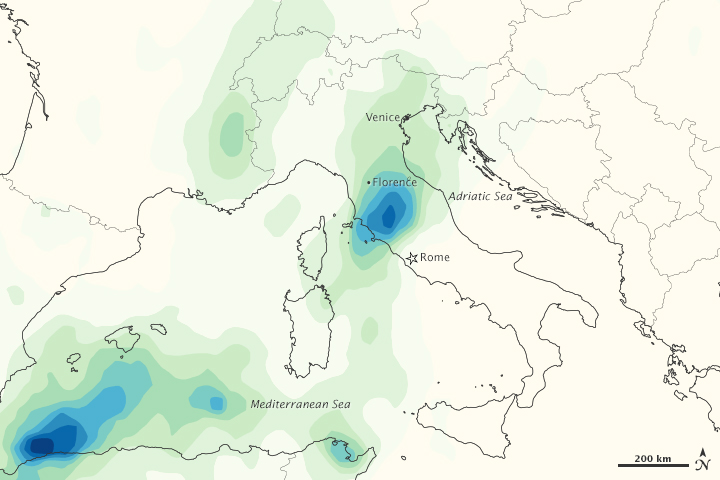


A low-pressure system stalled over northern and central Italy in early November 2012. At least a half-inch (13 millimeters) of rain fell daily for five consecutive days, and often more, AccuWeather reported. Some of the heaviest rainfall struck Tuscany and Umbria, according to the Flood Observatory.
This map shows rainfall totals in Italy and other areas around the Mediterranean Sea from November 6 to 13, 2012. The heaviest rainfall—more than 320 millimeters (12.6 inches)—appears in dark blue. The lightest—less than 40 millimeters (1.6 inches)—appears in light green. Trace amounts of rain appear in pale yellow. The heaviest rainfall is concentrated southeast of Florence.
This image is based on data from the Multisatellite Precipitation Analysis (MPA) produced at NASA’s Goddard Space Flight Center. The MPA estimates rainfall by combining measurements from many satellites and calibrating them using rainfall measurements from the Tropical Rainfall Measuring Mission (TRMM) satellite. Because this image is an estimate of the rainfall recorded over a very large area when the satellites were overhead, it may miss pockets of heavy rain in smaller areas, or short periods of more or less intense rain. As a result, local rainfall totals measured from the ground may differ from the estimates shown here.
The heavy rains in November 2012 appeared to fit within a pattern from the past decade or so. AccuWeather reported that the long-term average for rainfall in November in Italy is 80 millimeters (3.14 inches). However, November precipitation totals have surpassed 100 millimeters (3.93 inches) seven times since 1999.
In November 2012, rivers in Tuscany burst their banks as residents awaited rescue from their rooftops. In the area of Carrara alone, about 50 people had to be evacuated. The head of Tuscany’s regional government asked for intervention from the army to assist with rescue and cleanup efforts.
Venice also suffered severe flooding in November, brought on by a combination of heavy rains and strong winds from the Adriatic Sea that pushed seawater onshore, the Weather Channel reported. November is typically the rainiest month for Venice and Florence.
NASA Earth Observatory image by Jesse Allen, using data from the TRMM Science Data and Information System at Goddard Space Flight Center. Caption by Michon Scott.